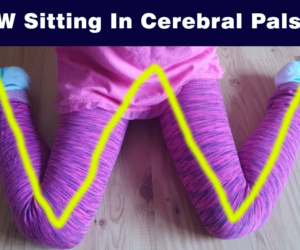Negative Effects of ‘W’ Shape Sitting Position of Children & its Prevention Techniques

Child sitting with the bottom on the floor and with their legs outstretched, forming a “W” shape is termed as W sitting. The negative effects of the W sitting position may not be seen after sitting once or twice, but changes and complications adapt in the musculoskeletal structures due to continuous adaptation of the posture while sitting.
Effects On Children Due To W Sitting
When a child adopts this posture the bilateral hip joints go for extreme internal rotation which develops extreme tightness of muscles lie inside called hip adductors and stretches the muscles over the abductor compartment. This extreme rotation can cause a knock-kneed position (genu valgus stress) and/or in-toeing of the feet (inversion). Apart from this, W sitting can be an indication of weak trunk muscles as this position allows children to adopt a stable base and use the ligaments around their hips for stabilizing themselves instead of using their core muscles resulting in core weakness.
How to break the habit:
- When the child goes for W sitting, the child has moved into an alternate position. There are several options needed to adopt by a child-like: circle sits, ring sit, side sit, and long sitting.
- Verbal cueing will be helpful by the parents or attendants to remind the child about the change of position
- Normally the child adopts this posture while playing, if we provide seating options like a chair, the stool will be helpful to maintain the upright posture without losing balance, due to w sitting the children are mostly confined to play in midzone areas which limits the equisition of motor and cognitive skills.
Alternate Positions To Avoid W Sitting
- Tailor Position
In this position, the child truncal muscles are activated & engaged with head, neck, shoulders in the proper position for performing activities. Less strain over the joints of the lower extremity as the pelvis is more in the neutral position, the child can easily move into derived positions from tailor sitting to side sitting, quadruped, kneeling and half-kneeling. Once the child achieves tailor position one can target the child position challenging by making the child sit on Dyna disc under the bottom in tailors position.
Check out these links for
relevant information: Neurological physiotherapy, paediatric neuro,
For more details contact
us on 📞9618906780
